To a certain kind of gamer, Diablo is sacrosanct. Arriving for PC in 1997, the first game in the series evoked all the most hellacious phantasmagoria ever dreamt up in a basement-bound Dungeons & Dragons campaign, neatly packaged in an endlessly replayable hack-and-slash RPG. A smash hit, its publisher, Blizzard Entertainment, would quickly follow with with 2000’s Diablo II, and that’s where things really began to heat up.
The highest-selling PC game ever at the time, Diablo II would help cement the legacy of the series as both highly influential and unassailable — at least, for those first two games. As the developers would find out 12 years later, when releasing Diablo III, the fans had a very specific idea of what the franchise was supposed to be, and anyone who’s ever spent time at an internet café or toiled away at an overnight LAN party knows, these fans take it very seriously.
But here we are, over a quarter century since its initial release, and like plenty of other legacy series this year, the franchise is returning from the dead once more. Following the celebrated remaster Diablo II: Resurrected, which paved the way with good intentions, Diablo IV is primed to bring cooperative dungeon crawling back in all its glory.
And despite having undergone their own tribulations to get there, the team at Blizzard Entertainment have reason to be confident in the game’s success. After an extremely open dialogue with the fans around the development process, including multiple open betas and a massive “server slam” event, the feedback loop has been healthy and the consensus overwhelmingly positive. Diablo’s back, baby, and it’s one hell of a good time.
Ahead of the final push to release, Rolling Stone sat down for multiple conversations with the development staff, including game director Joe Shely, art director John Mueller, audio director Kris Giampa, and lead composer Ted Reedy to plunder the depths of their process for sending players to hell in a hand basket.
Here are the major tenets of Diablo IV from the creators themselves.
Welcome to hell.
Blizzard Entertainment
Everlasting Appeal
Joe Shely (game director): The great thing about Diablo is that it’s really easy to play. Whether you’re playing on a mouse and keyboard or a controller, however you interact with games, it has a very easy interface. And the fantastic thing about a Diablo game is that you get to slay a bunch of demons, right? And they explode in really satisfying ways. And your character gets stronger, and you get to slay even bigger demons.
John Mueller (art director): And we have a kick ass heavy metal story.
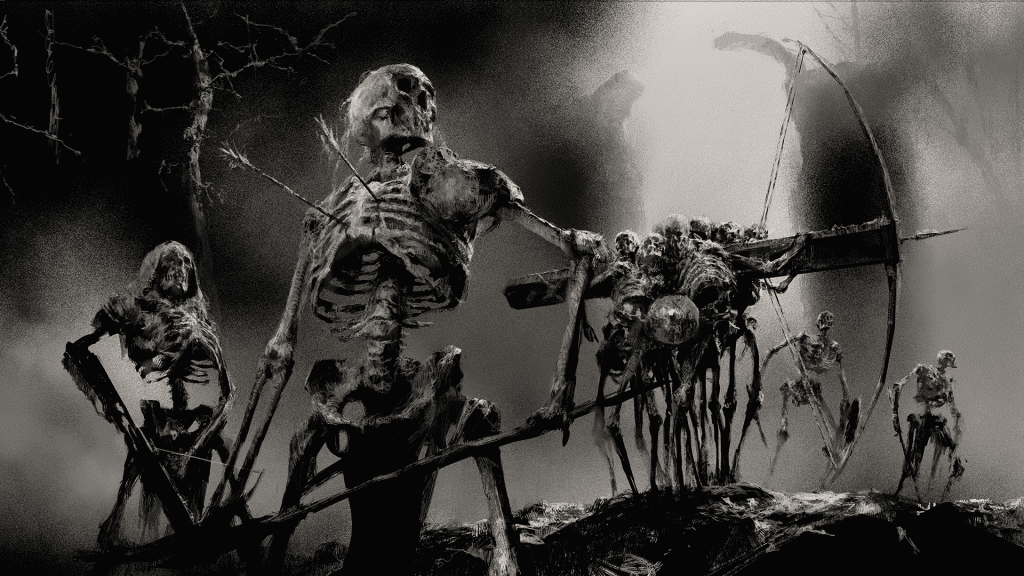
Sweet embrace.
Blizzard Entertainment
Embracing the Legacy
Ted Reedy (lead composer): It can be very abstract at the beginning. [We] want to hit the emotions of tension, fear, darkness, endless strife, madness, grotesqueness; We want to return to darkness, respect the legacy of earlier games, never be static, earn interactivity. [We] have all these concepts in our head so that when we start to respond to the art and the environment as they get filled in by the artists and the story by the narrative team, they’re just kind of in the back of our mind as we go through the creative development process.
Kris Giampa, (audio director): [Diablo] is video game royalty, right? Like it’s, it’s a top tier RPG, and we want to pay it justice. So, we reference the older games for sure, we actually bring certain sounds over. One of the key sounds you’ve heard from game to game is the generic flippy sound when an item comes flying out from a corpse or whatever. And that is just an iconic sound that we want to bring along.
In regard to Diablo IV, we really wanted to go extremely dark and gritty and gothic as much as possible and never stray from that unless the moment in the game kind of plays it up to be a reason for that. So that was one of our pillars — it’s called “darkness prevails” from the audio side — is just always think about darkness, gore. Gore is a key thing for Diablo so we get to go really full deep into it.
Reedy: Obviously, the other composer on the game, Leo Cholesky, [and I] grew up playing Diablo I, Diablo II. We idolize the game and those soundtracks, it’s probably part of the reason why we wanted to have a career in writing music for video games. At the same time, if we try to just emulate or copy or mimic exactly that score, then probably what would come out is something unoriginal and not as good as it could be.
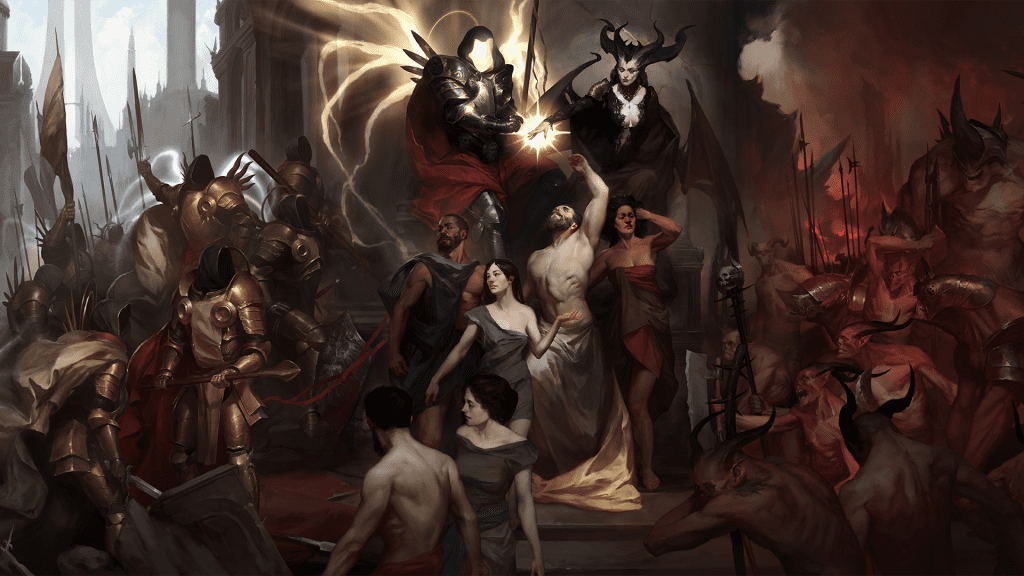
The Old Masters
Blizzard Entertainment
The ‘Pillars’ of Vision
Mueller: We have pillars, and one of the pillars was called the “Old Masters” pillar. And the “Old Masters” pillar was a way to galvanize our vision. We’re trying to create something that feels like a medieval masterpiece. We wanted the colors and the tones and the textures of the world to remind us of that. Not verbatim, but we didn’t really look at photography as our — we weren’t looking at it like, “Okay, this is what this scene is going to look like as a photograph.” We were looking it like, “What does it look like as a painting?” And not just a painting but something that feels old, like the palete’s kind of muted and the tones. And a lot of people — we’ve had this feedback — feel it in the game.
Giampa: “Living Audio” is one of our pillars for the game as well (like “Darkness Prevails”) and because of the tools we’re using nowadays we can implement a lot of randomizations, slow movement over time. When it comes to the ambience, I really wanted to play up the ambience in Diablo IV and treat it more like on the level of hero sound design, where it’s its own hero. So, we put up an amazing amount of time in just the ambience itself. And the randomization in that where we have like a slow moving subtle LFO over time that is just playing with volume and maybe pitch. It’s not meant to be noticeable. It’s meant to be very subtle.
The goal was to just always have the game, if you’re standing still just listening, it’s always slightly moving, slightly bending and over time changing and it feels like it really paid off. Because when you stand in an area, I kind of don’t want it to sound exactly the same every time because that gets back to the annoyance factor — ear fatigue.
Mueller: “Return to Darkness” was one of them. “Embrace the Legacy” was another one. And that was just the idea of really understanding that this is a game [where] there’s a lot of expectations. And there’s also a lot of things that we want to bring from all the all the Diablos that we really liked while innovating in our own way.
Shely: I think one of the really interesting things about the “Embrace the Legacy” pillar is that a superficial reading of that would be just [making] sure that people who’ve played previous games are happy. And we talked about the ways that that’s important. But the other legacy of Diablo is that, since its creation, it has been a kind of game that people who have not played a lot of RPGs can easily get into, right? The action combat makes it more accessible.
We work hard to introduce new players to concepts, we work hard to make sure that complex, deep systems are introduced slowly to the player or after the player is familiar with it. And our emphasis was on story. [Story] is another way that can help make the game accessible to someone who isn’t feeling familiar with Diablo because of course, all humans like stories. And a story is something that can connect across people really well.

The Fractured Peaks
Blizzard Entertainment
World Building, Big and Small
Shely: Since this is the fourth title in this series, we know that we have a fan base of people who know Diablo and they have expectations. They know what Diablo is, [so] Diablo IV needs to be these things. And these things are things like having a really dark mood and tone and world, right? And that doesn’t just mean that we turn the lighting down so things are mostly black, right? It means that there are stakes and that it’s grim. And it’s not a world where everything is going right, and to a large extent it’s up to the player to affect change in that world, to help other people in the world, to slay demons.
Mueller: I think two words that come to mind are “authenticity” and “believability,” or “grounded-ness.” [Because] we made the decision to make a connected open world with towns and villages and things that feel like a real place — the mud and dirt and grit of that world — the characters in the armor and all the things that you see about players need to kind of reflect that.
I think it’s different than other entries in the series in that way. You know, interesting that we thought we had to think about, “What armor do I find in Scosglen?” Because it’s sort of this druidic area. So, the things that drop here look like they’re from the area, where if I’m in Kehjistan, which is more desert region, the things that drop look like they’re from here, instead of just like, “Oh, I just found something that doesn’t look like it belongs here at all.”
So, we expended a lot of effort to try to apply, “What does it mean to have an open word in a game with all these classes that have these unique backstories and aesthetics to them?” [One] thing we wanted to have is, when you look at the five classes at launch, [if] you put them in a lineup in this Scosglen gear, they all look like they’re from Scosglen. I think that was a really cool opportunity that we embraced and figured it out.
Reedy: We want to create an environment that is all the things we talked about before: dark, bleak, depressing. But at the same time, it’s also inviting in a weird way? So, you want to spend time there nostalgic for the past, in terms of our own lives playing these games, but also the characters’ lives, the world that existed before all this evil came.
I think earlier games were smaller in scale and more focused [on] constantly having action, [so] they were a little bit more bombastic and percussive throughout. And here, we realize how big of a change this is, having this huge open world [that] can get explored over many, many hours.
We don’t necessarily want it to be overbearing constantly; we want it to be a place where you want to spend time, you want to explore, and then when the action does happen, it’s more meaningful and we try to highlight the more meaningful action moments in concise and specific ways.
Mueller: We wanted to give more space to the transition areas, and to make it feel naturalistic, so it doesn’t feel like you’re just going from the “snow zone” to the “desert zone.” The way we connected it, and even the order that we connected, it feels softer than what [you] might have experienced in other games today.
[We] have these areas, we call them transitioners. And they’re huge, pretty good-sized chunks of areas that are just dedicated to that transition of that biome. And then, within a biome, we also have tons of sub-biomes. So, like Fractured Peaks, [if] you explored the whole region, you’ll see that there’s areas that are — we call it like the glacial biome — and then there’s the permafrost, the muddy areas down here, [that’s] where the melt is coming off the glacier.
We really did a lot of planning on the water that’s in Hawezar came from the glaciers of Fractured Peaks, and so there’s a huge drop off, and that water goes down, and there’s waterfalls all around and spilling into Hawezar. That kind of connectedness never… we never had to deal with that before. It was a challenge, but it’s really fun challenge.
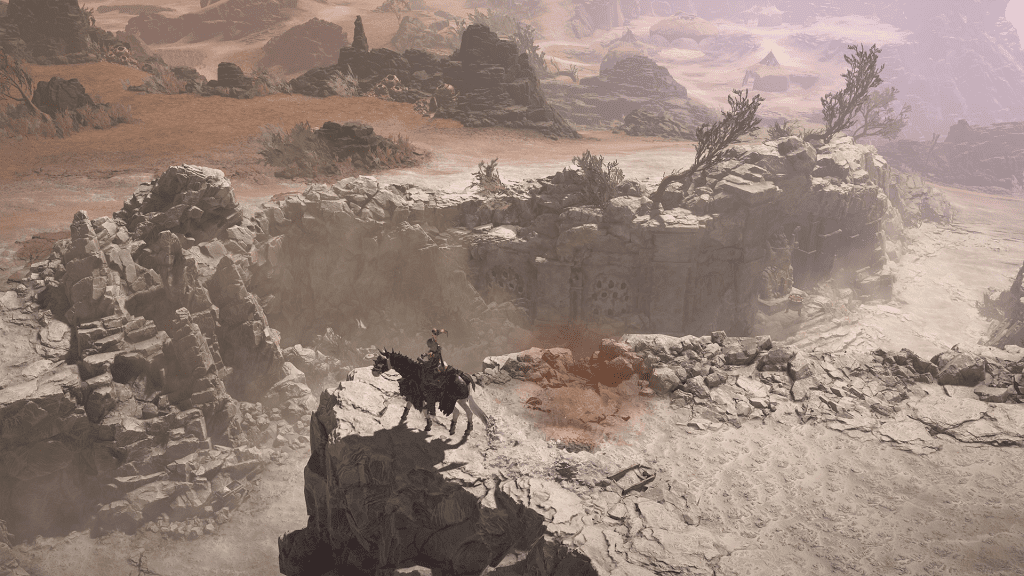
Wow, that’s so random
Blizzard Entertainment
Variety Through Randomization
Mueller: [This is] almost 30 years of Diablo games at this point and [it’s] the expectation for ourselves and everyone else that this was going to be the pinnacle of that experience. It should have all the things that players expect — that our fans expect. We need to give them everything they want. [And also] the things that we wanted to bring.
One of those things was that dark tone; when we looked at all of the games, we were like, “This darkness, this tone, this gothic horror fantasy is really foundational.” And so, bringing that back but also not losing the sense of wonder and exploration that Diablo III had in different areas where new areas would open up and the color palette would change, and it would be vibrant.
We still have lots of moments like that in the game where you’re now exploring a huge open world that’s just massive and that has to have a lot of variety and tone for it for it to be fun, otherwise it just starts to feel like one note or monotonous over time.
Giampa: [We] really kicked up the visceral combat in Diablo III and we wanted to pay respect to that, going a bit overkill with the combat to where you feel extremely powerful.
[It’s] it’s a repetitive action you’re going to be doing for hundreds of hours over and over so we build in a lot of variation to every cast that you do, every impact that happens, the monsters themselves reacting to the combat. We build in just tons of variation, a lot of randomization to the gameplay of it when it plays back because if you don’t, it can get very repetitive and just kind of annoying.
Reedy: One of the things that we did, probably more so in this game than any other game in the Diablo series, is just the amount of recording that we did. And once we have written a piece of music, we then recorded a lot of the parts on as many different instruments as we possibly could.
So, say we originally wrote a piece in “Fractured Peaks” for string quintet, we took those string parts and gave them to our guitar player, gave them to our wind player, and however many they could play in a range of a certain instrument, we got them on different wind instruments, different guitars.
And those wouldn’t go in the full mix of the main track, but we have those as assets, and we put all of those in the game. And then we can use the engine to randomize what’s playing the melody, what’s playing the harmony, maybe we just play the harmony here. And so those tracks feel different every time and we can program however many different variations we want. Then we can control the order in which they’re played so the sequence can be random as well.
With all the randomization that we’ve done, both in the sequence and within the tracks themselves, no one should have the same music experience that plays this game — it’s going to be completely random. That’s one thing that we were inspired by the original Diablo game. Diablo I, when it had the random dungeons, we want the game to feel different every time.
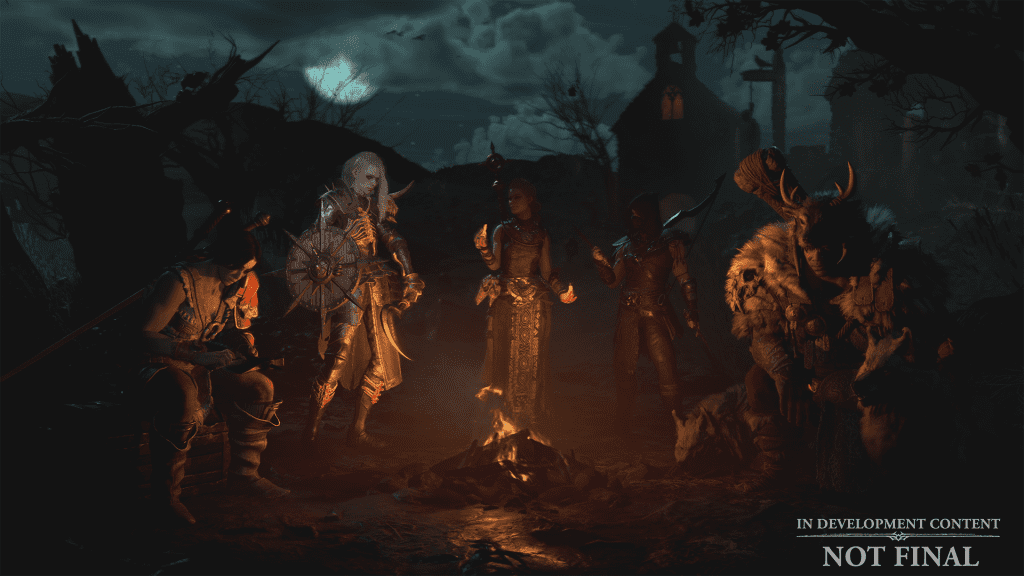
Everyone gather round the campfire
Blizzard Entertainment
Player Driven Fantasy
Mueller: [Character creation] has never been in a Diablo game before. This was like, “Okay, well, it’s a Barbarian.” And [the] Barbarian has a very distinct identity within the Diablo universe. And so, we have to stay within the guardrails of that a little bit. Because the Druid is different, the Rogue is different. Now the opportunity is there is that the personalities that you’re portraying feel a little different. The Rogues look kind of cutthroat. They look a little like they could be thieves, [if] they’re being cast in a film.
We thought of it almost like casting, because we didn’t do the thing with sliders where you just can make like weird looking faces and stuff, we wanted the characters to have a persona that matches the world matches the tone of the world. And then give players a lot of options to Mr. Potato Head a lot of stuff onto your character that feel really kind of also like inworld, and don’t pull you out of the fantasy.
But at the same time, we have green hair and purple hair and stuff like that, but it’s like still kind of toned down because we don’t want it to be immersion breaking for the player that wants to have that more [immersive] experience.
Giampa: One cool thing we haven’t really talked about with anybody yet is that the foley, what you’re wearing in the game now actually changes when you swap it out. We didn’t we haven’t done that before in a Diablo game. So, what helm you’re wearing, what chest piece you’re wearing, what legs you’re wearing, will actually swap out the sounds. So, if it’s like plate male versus leather, you’ll hear that swapped out. And it’s pretty subtle. And that’s kind of the thing where it just grounds you in the world more. And we wanted to backup that tie to the art because the art is beautiful.
Mueller: I think there’s two ways that I think of experiencing that character, which is the character that’s in my mind that I have developed, and I grow over time. Diablo is a game that you play when you’re not playing it, in your head. You play it in your head a little bit. And [the] persona of the character kind of exists in my mind, it’s almost like a book, and so that character develops an identity in my mind. And when I see that login screen, and when I see that character full screen, that’s what stuck in my mind, that’s my character.
So, even though we pull out in game, you see him in the in-game cutscenes, which is a really nice feature that we added. [Your] story is interwoven in the game in a way that we’ve also never done. And the player is doing a lot of work in their own mind about the identity of their character. So, we’re just trying to give them the quality and the and the production values around that. Make it feel good.
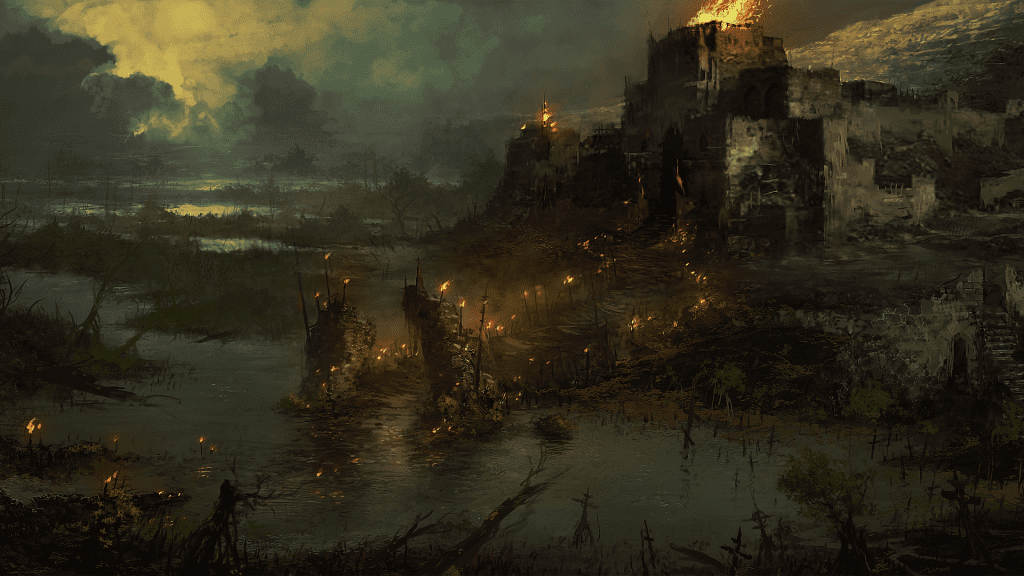
Fire counts as light.
Blizzard Entertainment
Finding Light In the Darkness
Reedy: One example I like to think of, playing video games back in the day: Castlevania II, to me, felt very overbearingly dark almost to an extent that I didn’t want to play it all the time. But Castlevania: Symphony of the Night was a game that I just wanted to spend so much time and I think a lot of that… it wasn’t all to do with the music. But the score can help create a sense of an environment and atmosphere that you just want to be a part of. And if it has enough contrast, so where it’s not always dark, bleak and depressing all the time, but has little sublime moments or moments of hope, it kind of reminds us what we’re fighting for.
Why are we slaying all these demons? Who are we trying to help? So, that is something we’re constantly conscious of, is having the right balance of darkness versus little moments of hope.
Diablo IV launches June 6 on PC, Xbox Series X|S, Xbox One, and PlayStation 4 & 5.
